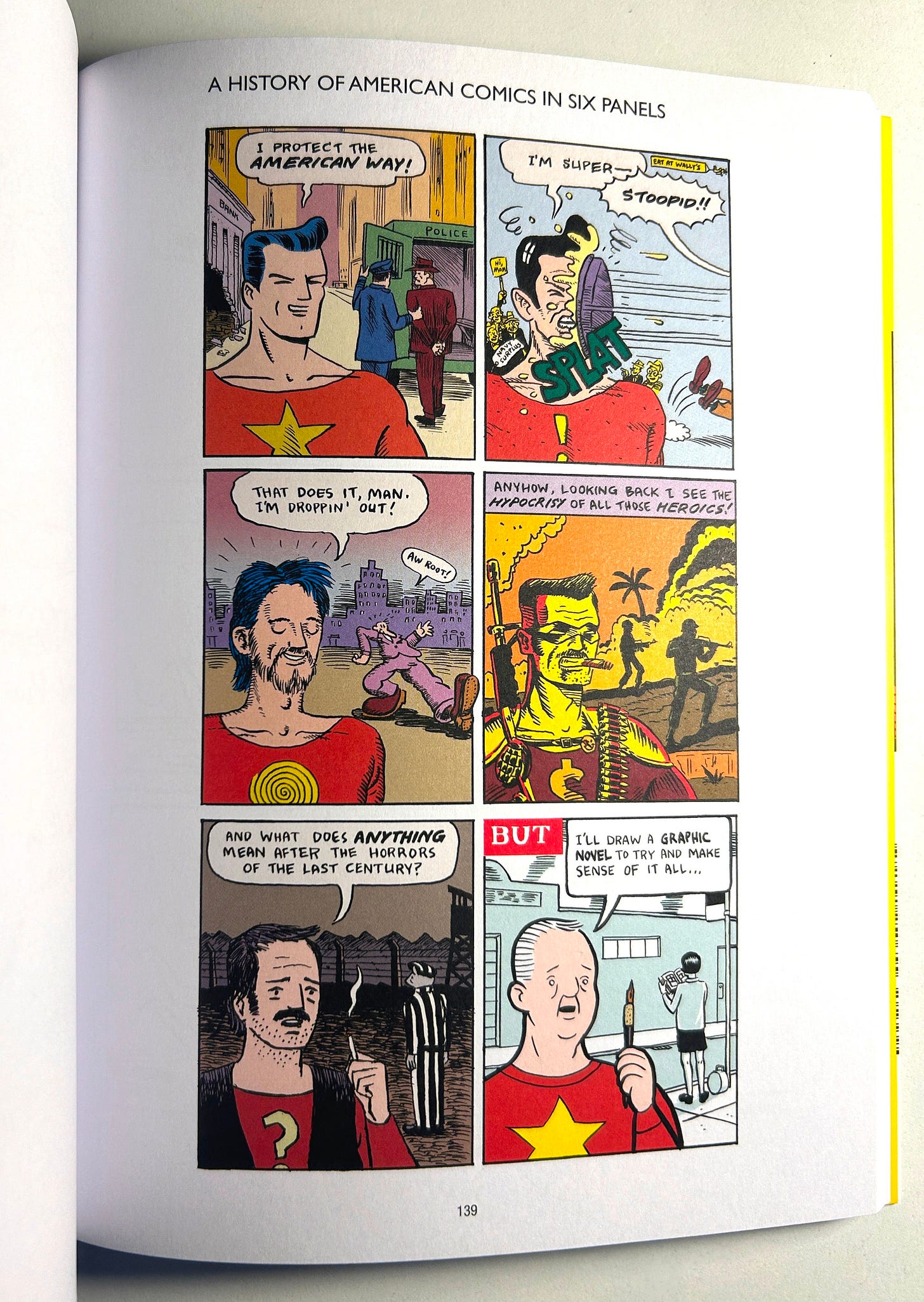Here’s a comic of mine from 2012:
This comic came about as a commission from Colgate University’s alumni magazine, Scene, which featured an article about the history of American comic books by Professor Paul Lopes.
In addition to the usual professional constraints of format, subject, and deadline, the art directors suggested I make the illustration a comic: the assignment was suddenly much more interesting! By making a comic for this space I could use the constraints of the medium to further focus my creative attention. I knew a panel grid would be visually pleasing as well as helpful for my next step: figuring out what to put in the panels.
I thought it over and hit upon a repetition-with-variation constraint where the basic composition stays the same but I change certain variables in each panel.
This kind of conceit is used with some regularity in the history of comics, dating back at least to the work of Winsor McCay on through R. Crumb’s “A Short History of America” and Oubapo’s numerous works in this area, most notably François Ayroles’ tragicomic 8-panel biography of pop singer Claude François from OuPus 3: Les Vacances de l’Oubapo, which was the most direct influence on this comic:
It occurred to me that I could express the history of American comic books through the evolution of superheroes, who largely defined this particular era (roughly 1940-2010). If I foregrounded a superhero character with a word balloon, I could change details from panel to panel in a way that would move us from Action Comics #1 (the debut of Superman) to the age of the “graphic novel.” I could use the less-defined background to add context.
In case you haven’t already identified them, here are the artists and titles I borrowed from in each panel:
panel 1: Siegel & Shuster’s Superman
panel 2: Harvey Kurtzman & Wally Wood’s parody, “Superduperman” from Mad Magazine
panel 3: an R. Crumb pastiche, featuring one of his iconic “keep on truckin’” figure
panel 4: Alan Moore and Dave Gibbons’ Watchmen (this panel is copied pretty directly from a Vietnam flashback in the book)
panel 5: Art Spiegelman’s Maus
panel 6: the foreground figure is a Chris Ware character (equal parts Jimmy Corrigan and “Super-Man”) and the background is an invented outtake from the final pages of Daniel Clowes’s Ghost World
I was only able to pull this particular assignment off because the subject matter was so relatively narrow: American (not international) comic books (so, no newspaper comics)—a helpful constraint that came baked into the assignment.
Over the years, a few people have riffed on my comic, such as a Spanish cartoonist signing as XSER who envisioned a parallel history of Spanish comics or a comics professor who has his students add panels to my six (ranging from Charles Schulz to Raina Telgemeier). It is not intended by any means to be a definitive statement so I love to see people reacting to and expanding upon my work.1
The art directors later invited me to write a short commentary that they dropped in the article as a sidebar:
A final constraint came up when I decided to include this comic in my new collection. Well, two actually: first of all, I have done very few comics in color. To include this one page plus a handful of others creates a significant expense for my publisher, plus we need to place them in the same section of the book for printing reasons which I won’t delve into right now.
In addition, you can see that “A History of American Comics in Six Panels” was tailored to a very specific, horizontal format that is typical for a magazine illustration but totally different from the size and ratio I usually work in. There was no perfect solution here but I found that reformatting the strip vertically sat slightly better in the layout for Six Treasures of the Spiral:
As I mentioned above (with a hopefully-not-too-offensive button), you can order a (roughly) 19” x 14” offset print of this comic here. This was printed on a lithographic Heidelberg press in Portugal and it makes a fantastic gift for the comics lover in your life:
“A History of American Comics in Six Panels” is just one of the many jewels included in my collection of constrained comics, Six Treasures of the Spiral: Comics Formed Under Pressure, now in stores!!
Publishers Weekly gave it a starred review, calling it “an instant classic.” (Read the whole review here.)
Upon reviewing Prof. Labarre’s blog post I have to acknowledge that skipping Silver Age Marvel Comics was a pretty major omission! Maybe I should have done an 8-panel version including references to Spider-Man and Archie Comics?












As you know, I love that repetition print! I have it hanging in my house. My only criticism of the remix by students is it looks like they combined Frank King and George Herriman in the first panel. I'm teaching a course on the history of comics now so I might refer back to this repetition comic. Actually, it would be a fun midterm question--identify these six styles.